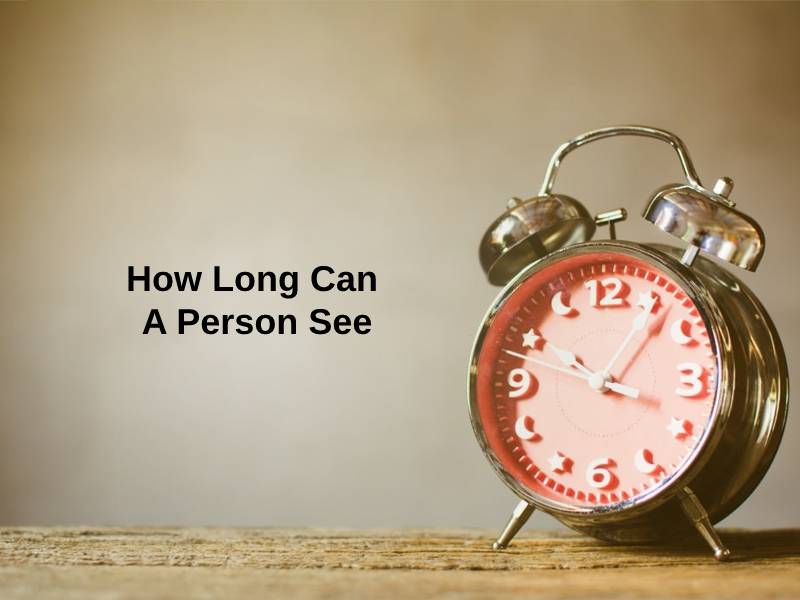Exact Answer: As long as one’s retina is intact
Human eyesight is a fascinating subject of research for most scientists across the world. The length of an average person’s visual range is vast, to say the least. Our eyesight is maintained by the optimal operation of the retina. Any damage to this crucial part of the eye will impair vision.
The human eye processes the light reflected from various objects. These rays enter the eye through the cornea and then reach the pupil of the eye. These light rays are then processed by the millions of neurons of the brain. The human brain operates to convert these light rays into electrical impulses, subsequently aiding in the formation of images.

How Long Can A Person See?
The vision of an individual will remain intact throughout the course of his or her life if their retina remains unharmed and safe. Diseases and abnormalities that affect the retina are the most common contributing, and causal inputs for vision loss.
Vision loss affects an older population. People aged 65 years and above may suffer from various eyesight-related health issues. If left untreated, these issues can aggravate into the permanent loss of one’s vision. Diseases like cataracts are most common among this group of people.
However, it is equally important to note that loss of vision and eyesight is not always age-related. The younger proportion of the population may also suffer from the loss of eyesight- either temporary or permanent. Accidents or degenerative diseases like Glaucoma may lead to vision loss among this segment of the populace.
Alternatively, sometimes children are born with certain congenital diseases that affect the retina of their eyes. In such cases, the baby may have to deal with vision-related problems or in most instances, complete blindness for the rest of his or her life.
Vision loss can also be triggered among people belonging to any of these age groups when they meet with an unforeseen accident that affects their optic nerve or their retinal layer. As it is very difficult to effectively repair the retina, such loss of vision may be permanent.
Nonetheless, there are also instances of temporary blindness among people. Such events may occur when the individual undergoes a traumatic incident, a major brain surgery, or endures a concussion. Usually, the individual’s eyesight returns within a short span of time.
In Summary:
| Causes of Vision Loss | Age Group Affected |
| Cataract | 65 years and above |
| Congenital Diseases | Newborns |
| Accidents and Traumas | Any age group |
| Degenerative Diseases | Middle-aged people |
Why Can a Person See This Long?
Without any impairments to the retina or optic nerve, people can enjoy unencumbered vision throughout their lives. It is only when either of these structures suffers a trauma that an individual is at the risk of losing his eyesight.
In the case of people above 65 years of age, the most common catalyst of vision loss is cataract. It is a kind of degenerative disease that affects the retina, slowly impairing one’s visual capacities. If left untreated, cataracts can continue growing and will finally lead to permanent blindness in the concerned individual.
Another common eye disease that affects this age group is called age-related macular degeneration. The effects of this disease are much too similar to cataracts. It affects the macular or the center of the retina.
Congenital diseases affect children who are born with these defects. They may be born with abnormalities in the optic nerve or retina. This may lead to a complete loss of vision right from birth or soon afterward.
In the case of the younger segment, visual impairments and a total loss of vision are caused by eye injuries or certain traumatic accidents. In such cases, major arteries or veins connected to the eye may be damaged and subsequently lead to the resultant visual impairment.
Degenerative medical conditions like diabetes and glaucoma may severely hamper one’s vision. This affects middle-aged people. They both affect the retina, causing the accumulation of starch in the structure. This leads to vision loss that can be corrected through surgery and medication.
Conclusion
The peculiarity of human vision has perplexed many scholars over the by-gone centuries. The key element of understanding human vision has always remained its examination under pristine and untainted conditions. Maintaining healthy eyesight is important to avoid any future possibilities of vision loss.
Vision loss is caused by age-related problems, traumatic injuries, and degenerative medical conditions. In the event of any such condition, one may be unable to see the world around him as the retina of his eyes may be severely damaged. However, one must remember that a healthy diet can help prevent the development of most degenerative conditions.